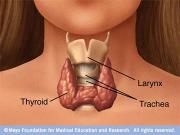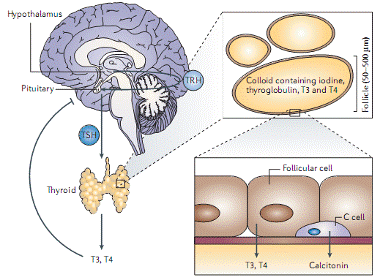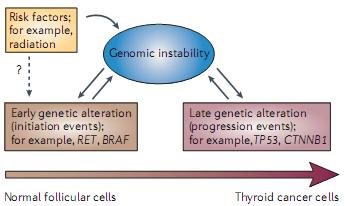


|
Anatomical features of the thyroid [13]. |
|
Overview |
|
Comprising of follicular and parafollicular C cells, the thyroid glands are the largest endocrine organ in the human body. It is responsible for the regulation of systemic metabolism through the modulation of thyroid hormones triiodothyronine (T3) and L-thyroxine (T4) [1]. Functioning through the anterior pituitary gland, the hypothalamus secrets thyrotroponin releasing hormone (TRH) which induces the release of thyroid stimulating hormones (TSH) [1]. TSH in turn induces the thyroid gland to release T3 and T4, which affect broad cellular metabolic activities such as increased metabolic rate and protein synthesis [1, 2]. |


|
Figure 1: Physiological Role of Thyroid Gland [1]. |
|
Due to induced-chromosomal instability such sources as radiation and hormonal changes affecting cell proliferation, i.e. estrogen, the thyroid gland represents the most common form of endocrine malignancies. Thyroid cancer is particularly prevalent among women who are 3-4 times at higher risk than men.
Malignancies within the thyroid gland can be classified into four distinct forms based upon cellular origin as well as aberrant chromosomal aneuploidy and overlapping nuclei. Specifically these four classes of malignancies are papillary carcinoma, follicular carcinoma, medullary carcinoma and anaplastic carcinoma. Papillary (PTC) and follicular (FTC) carcinomas is thought to arise from the follicular cells while medullary carcinoma (MTC) is thought to arise from parafollicular C cells and the most lethal form, anaplastic thyroid cancer (ATC), is a result of progressive disintegration of both papillary and follicular malignancies [3, 4]. With over 350,000 new cases per year within the United states alone and a prevalence of over 360,000 cases, thyroid cancer is among the fastest and most common form of cancer, with papillary malignancies accounting for over 90% of diagnosed cases [3]. The prognosis of PTC, FTC and MTC or optimistic with 10% survival rate of over 90% and a 10 year recurrence of 20%, ATC, however, often results in poor prognosis with 5 year life expectancy under 1% [6]. |


|
Figure 2: Steps in Tumorigenesis [1]. |